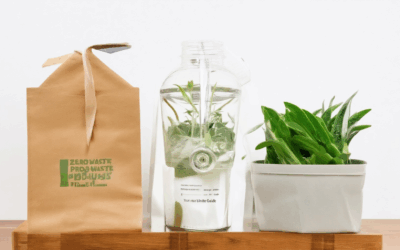Embracing a greener lifestyle is not just a trend; it’s a commitment to a healthier, more sustainable way of living. In today’s fast-paced world, more people are seeking ways to reduce their environmental footprint while creating comfortable and functional homes. A green home lifestyle offers numerous benefits, from lowering utility bills to contributing to a cleaner planet. Whether you’re new to eco-friendly living or looking to deepen your existing practices, this guide will walk you through the essential aspects of adopting a sustainable lifestyle. From understanding the basics of sustainability to exploring the practical steps you can take, we’ll cover everything you need to know to create a home that aligns with your values and the Earth’s health. Join us as we dive into the world of eco-friendly living, where small changes can make a big difference.
Key Takeaways
- Minimize waste and conserve resources by reducing plastic use, recycling, and composting organic materials.
- Save energy and reduce costs with energy-efficient appliances and sustainable transportation options.
- Eat healthily and sustainably by incorporating plant-based meals and supporting local farms.
- Lower your carbon footprint by opting for public transport, biking, or walking.
- Improve your home’s efficiency with solar panels and eco-friendly building materials.
- Make mindful choices to reduce unnecessary consumption and support local businesses.
- Educate yourself and others about environmental issues to foster a culture of sustainability.
- Inspire others by sharing your green lifestyle and encouraging small, meaningful changes.
These key takeaways encapsulate the core strategies for adopting an eco-friendly lifestyle, emphasizing both personal benefits and broader environmental impact.

What Does It Mean to Live a Green Lifestyle?
Living a green lifestyle involves making conscious choices that minimize harm to the environment while maximizing benefits for yourself and future generations. It’s about adopting sustainable habits that align with ecological principles and contribute positively to the planet.
Key Components of a Green Lifestyle
Here are some fundamental aspects of embracing a green lifestyle:
- Reducing Waste
- Practice recycling and composting to minimize landfill contributions.
- Use reusable items like cloth bags, water bottles, and containers.
- Reduce food waste through careful planning and storage.
-
Conserving Energy
- Opt for renewable energy sources like solar or wind power.
- Turn off lights and appliances when not in use.
- Invest in energy-efficient appliances and technologies.
-
Sustainable Transportation
- Utilize public transportation, bike, or carpool to reduce emissions.
- Consider electric vehicles or scooters for lower carbon footprint.
-
Eco-Friendly Diet
- Adopt a plant-based or vegetarian diet to reduce resource use.
- Choose locally-grown, organic foods to minimize transportation impacts.
-
Water Conservation
- Install rainwater harvesting systems.
- Use low-flow fixtures to save water.
- Avoid excessive lawn watering and promote native landscaping.
-
Eco-Friendly Products
- Select biodegradable and non-toxic products.
- Support fair-trade and sustainably sourced goods.
- Refrain from buying single-use items unless necessary.
-
Sustainable Business Practices
- Patronize companies committed to sustainability.
- Support ethical labor practices and eco-conscious businesses.
- Boycott products that harm the environment.
-
Minimizing Carbon Footprint
- Offset unavoidable carbon emissions through carbon offset programs.
- Participate in community initiatives aimed at reducing emissions.
-
Advocacy and Education
- Engage in environmental advocacy and awareness campaigns.
- Educate others about the importance of sustainable living.
- Stay informed about environmental policies and regulations.
Eco Planeta Verde offers extensive resources and guides to help individuals adopt greener habits and make mindful decisions for a sustainable future. Explore their platform for practical tips and inspiration to live a more eco-conscious life.
For more information on sustainable living practices and eco-friendly solutions, visit Eco Planeta Verde .
How Does a Green Home Work?
A green home is designed to minimize its environmental impact while maximizing comfort and efficiency. Here’s a breakdown of how it operates:
Overview of a Green Home
A green home prioritizes sustainability in five key areas: energy, water, waste, air quality, and health. By integrating eco-friendly practices, these homes reduce their carbon footprint and promote a healthier living environment.
Energy Efficiency
Green homes often feature advanced energy-saving technologies and designs. Key aspects include:
- Solar panels to harness renewable energy
- High-efficiency appliances that consume less energy
- Insulation to reduce heating and cooling needs
- Smart home automation for energy management
Water Conservation
Water is a precious resource, and green homes employ several strategies to conserve it:
- Low-flow fixtures to reduce water usage
- Rainwater harvesting systems
- Greywater recycling for non-potable uses
- Drought-resistant landscaping
Sustainable Building Materials
The materials used in a green home are carefully selected to minimize environmental harm:
- Reclaimed wood for flooring and construction
- Recycled steel and aluminum
- Bamboo, a rapidly growing renewable resource
- Low-VOC paints and adhesives to improve indoor air quality
Design Considerations
The layout and design of a green home are optimized for functionality and sustainability:
- Passive solar design to capture free heat
- Large windows for natural light
- Eco-friendly roofing materials like grass roofs
- Seamless integration of outdoor spaces
By combining these elements, a green home creates a balanced living environment that’s both sustainable and enjoyable. Ready to make the switch? Explore our sustainable living resources to learn more about creating your own green home today!

Disadvantages of Eco Homes
Eco homes, while offering numerous benefits, also come with certain drawbacks that potential homeowners should consider.
- Higher Initial Costs: Building or renovating an eco home often requires the use of sustainable materials, renewable energy systems, and energy-efficient appliances, which can increase initial expenses compared to traditional homes.
- Construction Complexity: Eco homes may require specialized knowledge and skills for their design and construction, which can lead to higher labor costs or longer project timelines due to the unique requirements of green building practices.
- Material Availability: While the demand for eco-friendly materials is growing, their availability and variety can sometimes be limited, leading to supply chain challenges and potential delays in construction projects.
- Learning Curve: Homeowners may need to learn about sustainable practices, energy efficiency improvements, and eco-friendly maintenance routines, which can be overwhelming initially but become second nature with time.
Eco homes are a significant step toward sustainability, but understanding these potential downsides helps prospective buyers make informed decisions aligned with their lifestyle and goals.
For more information on sustainable living and eco-friendly practices, visit our Sustainable Living Guide or explore our Renewable Energy Resources .

How to Develop a Green Lifestyle
Adopting a green lifestyle involves making conscious choices that minimize harm to the environment while maximizing benefits for yourself and future generations. Here’s a step-by-step guide to getting started:
- Reduce Waste: Start by minimizing plastic use, recycling, and composting organic materials. Learn more about our waste reduction techniques .
- Consserve Energy: Opt for energy-efficient appliances and reduce your household’s electricity consumption. Explore our energy-saving tips for simple yet effective changes.
- Eco-Friendly Diet: Incorporate plant-based meals and reduce meat consumption. Discover our sustainable diet guide for healthier and environmentally friendly eating habits.
- Sustainable Transportation: Use public transport, bike, or walk whenever possible. Check out our sustainable transportation options to reduce your carbon footprint.
- Home Improvements: Make eco-friendly upgrades to your home, such as installing solar panels or adding insulation. Visit our home improvement guides for inspiration.
- Minimize Consumption: Practice mindfulness when shopping and avoid unnecessary purchases. Read our mindful consumption tips to reduce waste.
- Support Local Communities: Engage in local sustainability initiatives or volunteer for environmental organizations. Learn more about our community involvement opportunities .
- Stay Informed: Educate yourself about environmental issues and stay updated on sustainable living trends. Explore our education resources to deepen your knowledge.
- Be a Role Model: Inspire others by sharing your green lifestyle tips and encouraging them to take small steps toward sustainability. Share your journey with us on our story submission page .
Eco Planeta Verde is committed to helping you create a sustainable lifestyle through practical advice and resources. We encourage you to explore our website for more tips, guides, and tools to live a greener life.
What Are Some Green Habits?
We all can contribute to a healthier planet by adopting sustainable practices in our daily lives. Here are ten simple yet impactful green habits to consider:
- Reduce Waste: Minimize plastic use, recycle whenever possible, and compost organic materials to lower landfill waste.
- Energy Efficiency: Opt for energy-efficient appliances and turn off lights when not needed to conserve power.
- Sustainable Transportation: Choose public transport, bike, or walk whenever feasible to reduce carbon emissions.
- Plant Trees: Tree planting helps combat deforestation and improves air quality, making it a rewarding green habit.
- Support Local Farms: Buy seasonal and locally-grown foods to reduce food miles and promote eco-friendly agriculture.
- Conserve Water: Fix leaks, install water-saving devices, and limit usage during peak hours to preserve this vital resource.
- Minimize Chemical Use: Use non-toxic cleaning products and avoid harmful pesticides to protect both people and the environment.
- Get Involved in Cleanups: Participate in local clean-up drives or beach cleanups to contribute to a cleaner, healthier space.
- Adopt a Zero-Waste Lifestyle: Reduce packaging consumption and bring reusable containers for shopping and meals.
- Spread Awareness: Educate others about environmental issues and share sustainable practices to inspire collective action.
By incorporating these green habits into our routines, we can create a more sustainable and livable world for future generations. Remember, every small effort counts toward a bigger impact!

How to Create a Green Home
To create a green home, follow these essential steps:
1. Choose the Right Location
- Select a location with access to public transportation and amenities to minimize carbon footprint.
- Look for areas with renewable energy infrastructure nearby.
2. Design for Sustainability
- Use sustainable materials like bamboo, recycled wood, and FSC-certified wood.
- Implement passive solar design principles, such as orienting your home southwards and using shading devices.
- Install high-efficiency windows and doors to enhance energy retention.
3. Construct with Care
- Consider prefabricated components made from recycled steel and aluminum.
- Build walls with insulated concrete forms to improve thermal performance.
- Integrate rainwater harvesting systems for irrigation and water collection.
- Install solar panels to generate clean electricity for your home.
4. Opt for Healthy Interior Finishes
- Use non-toxic paints and adhesives free of volatile organic compounds (VOCs).
- Choose low-VOC flooring options like linoleum or cork.
- Install energy-efficient appliances, such as those with ENERGY STAR certification.
- Integrate smart home technology for automated energy management.
5. Practice Sustainable Living
- Reduce waste by recycling and composting kitchen scraps for garden use.
- Use biodegradable cleaning products and natural detergents.
- Conserve water with low-flow fixtures and greywater systems.
- Plant native vegetation to support local biodiversity and reduce lawn maintenance.
6. Enjoy Long-Term Benefits
- Evaluate federal and state tax credits for energy-efficient home improvements.
- Explore utility rebates and incentives for installing renewable energy systems.
- Experience reduced energy bills and increased property value over time.
By following these steps, you can create a green home that promotes environmental health, economic stability, and social well-being for future generations.




0 Comments